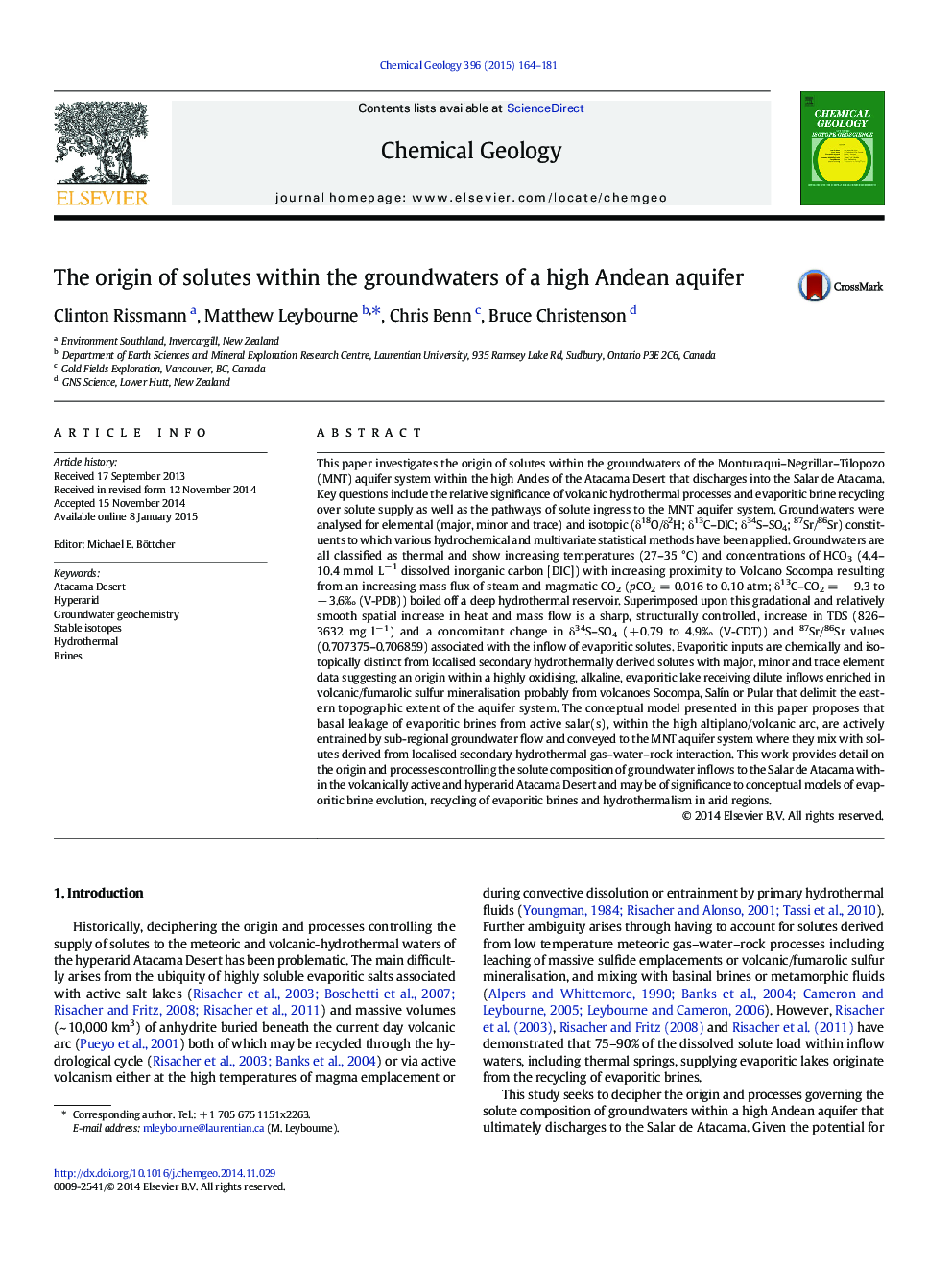| کد مقاله | کد نشریه | سال انتشار | مقاله انگلیسی | نسخه تمام متن |
|---|---|---|---|---|
| 6436514 | 1637577 | 2015 | 18 صفحه PDF | دانلود رایگان |
- Analysed high Andes waters for major & traces, stable (Sr, C, O, H) and Sr isotopes
- Thermal groundwaters occur in the Monturaqui Basin, proximal to Volcano Socompa.
- Increasing alkalinity near Socompa due to influx of magmatic CO2
- Groundwaters (S and Sr isotopes) influenced by recharge from evaporitic brines
- Thermal and brine signature overprinted by hydrothermal gas-water-rock reaction
This paper investigates the origin of solutes within the groundwaters of the Monturaqui-Negrillar-Tilopozo (MNT) aquifer system within the high Andes of the Atacama Desert that discharges into the Salar de Atacama. Key questions include the relative significance of volcanic hydrothermal processes and evaporitic brine recycling over solute supply as well as the pathways of solute ingress to the MNT aquifer system. Groundwaters were analysed for elemental (major, minor and trace) and isotopic (δ18O/δ2H; δ13C-DIC; δ34S-SO4; 87Sr/86Sr) constituents to which various hydrochemical and multivariate statistical methods have been applied. Groundwaters are all classified as thermal and show increasing temperatures (27-35 °C) and concentrations of HCO3 (4.4-10.4 mmol Lâ 1 dissolved inorganic carbon [DIC]) with increasing proximity to Volcano Socompa resulting from an increasing mass flux of steam and magmatic CO2 (pCO2 = 0.016 to 0.10 atm; δ13C-CO2 = â 9.3 to â 3.6â° (V-PDB)) boiled off a deep hydrothermal reservoir. Superimposed upon this gradational and relatively smooth spatial increase in heat and mass flow is a sharp, structurally controlled, increase in TDS (826-3632 mg lâ 1) and a concomitant change in δ34S-SO4 (+ 0.79 to 4.9â° (V-CDT)) and 87Sr/86Sr values (0.707375-0.706859) associated with the inflow of evaporitic solutes. Evaporitic inputs are chemically and isotopically distinct from localised secondary hydrothermally derived solutes with major, minor and trace element data suggesting an origin within a highly oxidising, alkaline, evaporitic lake receiving dilute inflows enriched in volcanic/fumarolic sulfur mineralisation probably from volcanoes Socompa, SalÃn or Pular that delimit the eastern topographic extent of the aquifer system. The conceptual model presented in this paper proposes that basal leakage of evaporitic brines from active salar(s), within the high altiplano/volcanic arc, are actively entrained by sub-regional groundwater flow and conveyed to the MNT aquifer system where they mix with solutes derived from localised secondary hydrothermal gas-water-rock interaction. This work provides detail on the origin and processes controlling the solute composition of groundwater inflows to the Salar de Atacama within the volcanically active and hyperarid Atacama Desert and may be of significance to conceptual models of evaporitic brine evolution, recycling of evaporitic brines and hydrothermalism in arid regions.
Journal: Chemical Geology - Volume 396, 9 March 2015, Pages 164-181
